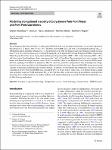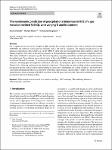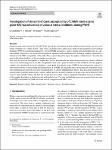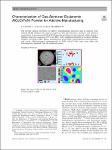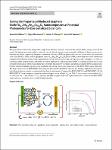Search
Author
- Manyk, T. (3)
- Murawski, K. (3)
- Baumgartner, Jörg (2)
- Guizani, Chamseddine (2)
- next >
Subject
Date issued
- 2023 (187)
Search Results
The elongational rheology of blends of a polystyrene (PS) Pom-Pom with two linear polystyrenes was recently reported by Hirschberg et al. (J. Rheol. 2023, 67:403–415). The Pom-Pom PS280k-2x22-22k with a self-entangled backbone (Mw,bb = 280 kg/mol) and 22 entangled sidearms (Mw,a = 22 kg/mol) at each of the two branch points was blended at weight fractions from 75 to 2 wt% with two linear polystyrenes (PS) having Mw of 43 kg/mol (PS43k) and 90 kg/mol (PS90k), respectively. While the pure Pom-Pom shows strong strain hardening in elongational flow (SHF > 100), strain hardening (SHF > 10) is still observed in Pom-Pom/linear blends containing only 2 wt% of Pom-Pom. |
For a significant increase in the strength of high-strength fine-grained structural steels with a nominal yield strength ≥690 MPa, the addition of microalloying elements such as Nb and Ti is required. The standard specifications for the chemical composition of these steels (e.g., in EN 10025-6) often only give the manufacturer limit contents to achieve the defined properties. The effect of the alloying elements in the heat affected zone (HAZ) is sometimes completely contrary. This makes it difficult to adequately predict the batch dependency regarding weldability and the load-bearing behaviour of the welded joint. Three different micro-alloyed steels of the grade S690QL were produced on a laboratory scale, focusing on different Nb and Ti contents. |
Creep-resistant steels such as the 13CrMoV9-10, used in the construction of thick-walled pressure vessels, are most commonly submerged arc welded (SAW). These steels can develop stress relief cracks (SRC) if the mandatory post weld heat treatment (PWHT) is performed improperly. Current PWHT parameters, such as heating rate and holding time at a specific holding temperature, are based on both empirical experience and conventional free shrinking welding experiments to characterize the SRC-susceptibility of the weld. These cannot adequately depict the higher residual stresses caused by the structurally induced stiffness of the surrounding construction. |
The conventional approach when engineering components manufactured from titanium is to design the thermomechanical processing to develop an optimal microstructure in a single alloy. However, this conventional approach can lead to unnecessary over-engineering of components, particularly when only a specific subcomponent region is under demanding service stresses and environments. One approach being developed to join multiple alloys in a single component and enhance engineering performance and efficiency is FAST-DB—whereby multiple alloys in powder form are diffusion bonded (DB) using field-assisted sintering technology (FAST). But the joining of multiple alloys using conventional welding and joining techniques can generate high residual stress in the bond region that can affect the m... |
Fusion-bonded and low-diluted overlay welded coatings are frequently very thick (>1mm). High-speed laser cladding is a novel process capable of producing thin fusion-bonded and low-diluted coatings with high coverage rates and low heat input. In this study, for the first time, high-speed laser cladding was used to fabricate relatively thin Ni-based coatings reinforced with chromium carbides onto low-alloy structural and quenched and tempered steels. Obtained coatings were characterized with X-ray diffraction (XRD), optical (OM), and scanning electron microscopy (SEM), as well as electron backscatter diffraction (EBSD). Mechanical and wear properties were tested with Vickers microhardness measurements and three-body dry-sand rubber wheel abrasion tests (RWAT). |
The appropriate matching of base and filler material is a complex task, where yield strength matching is the most general aspect. As the strength properties of structural steels have significantly improved in the past decades, the matching problem has become more relevant today. The mismatch phenomenon significantly affects the behavior of welded joints under dynamic and cyclic loading. Among cyclic loading, low-cycle fatigue (LCF) often occurs in welded steel constructions; furthermore, the LCF resistance of these advanced steels and their welded joints is limitedly known. In this paper, welding experiments are presented for the analysis of the LCF behavior of differently matched butt-welded joints made from two grades of quenched and tempered (Q + T) high-strength steels. For S690... |
The powder particle properties in additive manufacturing processes such as selective laser melting (SLM) influence the material properties. The microstructure, hardness, and chemical composition of gas-atomized AlCoCrFeNi powder particles were investigated, which showed a biphasic structure, consisting of FCC and BCC with a significant deviation in hardness. SLMed samples, consisting of BCC phase, indicated poor printability, inhomogeneous microstructure, and cracks. Microstructural inhomogeneity of SLM AlCoCrFeNi parts must reflect the inhomogeneity inherited from the atomized powder. |
This study set out to look at the influence of nickel additions on a commercially available AA7020 to understand the impact of the resultant intermetallics on recrystallization, formability and material strength. Elevated temperature tensile testing across a range of strain rates (5 × 10−4 s−1 × 10−1 s−1) and three temperatures (450− 500 °C) to compare material ductility followed by gas bulge testing at 475 °C and two gas pressures to investigate formability in a test closer to industrial forming conditions. Material strength was established using standard tensile testing, and EBSD used to understand the microstructural evolution of the materials. |
The generation of electricity using solar energy is an effective system to overcome the current global energy crisis. In this regard, developing new semiconductor materials can be of great interest in overcoming the challenge of charge carrier recombination and, hence, improving the power conversion efficiency (PCE) in photovoltaic devices, particularly dye-sensitized solar cells (DSSCs). Here, reduced graphene oxide-Sr0.7Sm0.3Fe0.6Co0.4O3 (RGO-SSFC) nanocomposites were synthesized using the hydrothermal method and characterized with the aid of microscopic and spectroscopic techniques, as well as a vibrating sample magnetometer, and further tested for application as photoanodes in DSSCs. Scanning electron microscopy revealed the presence of RGO nanosheets that were fully decorated b... |
Cotton (Gossypium species) was used as textile fibre already in the early Indus culture, and since then it has been cultivated in Tropical and Subtropical regions around the whole planet. The species G. hirsutum is nowadays the dominant cotton crop with more than 90% of the world market, while G. barbadense, G. herbaceum and G. arboreum combined, the other cultivated species of Gossypium genus total a minor part of world’s cotton production. Even in places where cotton was not cultivated, it could be an important trade item and income source for local textile centres, with the imported raw cotton lint being spun, woven and for some part exported from such sites around the globe. This all occurred far away from Finland, until changes brought by the development of long-distance trade ... |

